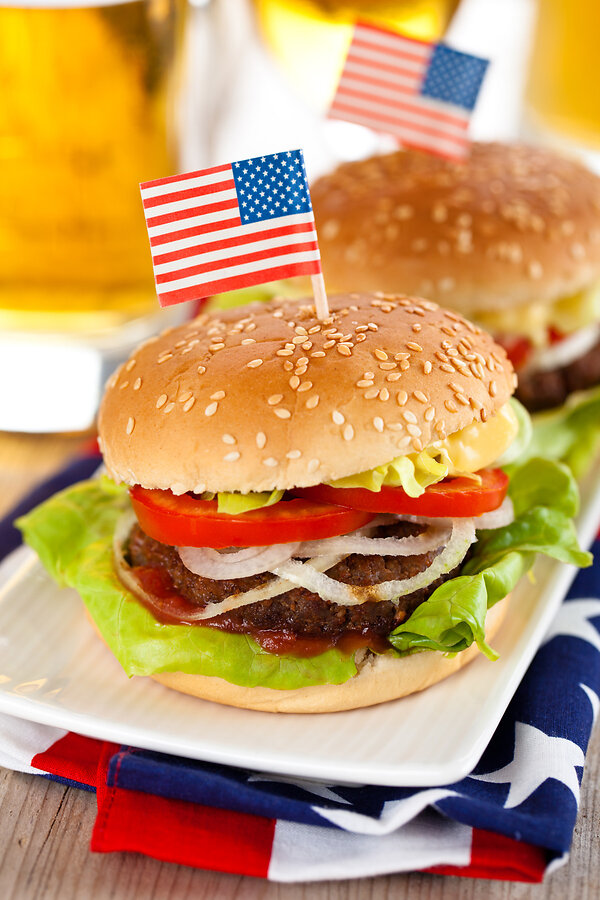 FIRE UP THE GRILL May is National Hamburger Month by Rob Lauer If there is any food that deserves the label of "All-American," it is the hamburger. Ask anyone on the street what foods they equate with the good old U.S.A., and there's little doubt that a beef patty on a bun would top the list. What is a Fourth of July cookout, and what is that cookout without patties sizzling on the grill, with buns and toppings close at hand. Some people still might talk about something being, "As American as apple pie," but most of us know that comparison is nonsense. The rest of the world obviously feels the same way. When the citizens of London, Paris, Hong Kong, Moscow, Jerusalem, and Cairo crave American cuisine, they head to their local McDonalds or Burger King. Just as we Americans are descended from immigrants, it should come as no surprise to learn that this most American of foods has roots in the old world stretching back to the Middle Ages. Like America herself, the hamburger is something of a cultural melting pot. The burger's roots go back over 800 years to Asia during the rule of Genghis Khan. While the Mongol Warlord could hardly be called the father of the hamburger, his attempt to conquer the world planted its culinary seeds. When one's life objective is global conquest, time management is crucial. Kahn rightly assumed that his Mongol horsemen would have more time to devote to conquest, sacking, and pillaging if they weren't stopping to set up camp, cook food and eat. They needed fast food that they could eat while riding. The answer? Chopped meat formed into patties were stored in leather pouches placed beneath the horsemen's saddles. The constant bouncing of the saddle as the horsemen rode for days would tenderize the meat, which would then be eaten raw. When the Mongols invaded Moscow in 1238, they brought their unique ground meat with them. The Russians adopted it into their own cuisine with the name "Steak Tartare." Over many years, Russian chefs adapted and developed this dish, refining it with chopped onions and raw eggs.  In the 1600s, German ships from the port of Hamburg began calling on Russian ports. During this period, Russian steak tartare was brought back to Germany. By the 1700s, Hamburg citizens began cooking the ground steak patties and serving them with onions and gravy. The dish became popular throughout Europe as "Hamburg Steak." When Germans began migrating to the U.S. in the mid-1800s, they brought "Hamburg Steak" with them. Because many of them were initially poor, gravy and onions were luxuries. It was cheaper to simply fry a patty and, if bread was available, slap it between two slices like a sandwich. During the late 1800s, the "Hamburg Sandwich" became the affordable, portable lunch of choice for many German immigrants employed as day laborers and factory workers. The 1904 St. Louis World's Fair proved to be the turning point in the story of America's signature food. At that event, a Texas food vendor named Fletcher Davis sold German fried beef patties on a bun, topped with ketchup and a slice of onion and pickle. The newly christened "hamburgers" could be bought by fair-goers, carried by hand, and eaten while they strolled through the fair's exhibits. The hamburger became the unexpected hit of the World's Fair, garnering praise in the national press. Praise for the food diminished in 1918 when the U.S. entered World War I. Overnight, all things German became unpopular. Hamburgers were given what some thought was a more American name: Liberty Sandwiches. Fortunately, that nonsense was quickly forgotten as soon as the war ended. In 1921, a Kansas City cook named Walter A. Anderson bought an old streetcar, painted it white, and began selling hamburgers for five cents each. They were so popular that Anderson started a string of small hamburger restaurants across the Midwest. Within five years, White Castle hamburger restaurants dotted the country, and America had its very first fast-food chain, paving the way for the humble burger to become the king of American foods. Today Americans consume over 50 billion hamburgers a year, averaging three burgers per person each week. The nation's top five burger-loving cities are Seattle, Philadelphia, Boston, Baltimore, and Miami. But America alone is not responsible for the burger's success: of all sandwiches sold worldwide, sixty percent are hamburgers. May is National Hamburger Month in the U.S.A., with May 28th being National Hamburger Day. The timing is perfect, as May marks the month when many Americans begin firing up their grills for backyard cookouts. For those who prefer that someone else take the reins of their food prep, most U.S. restaurants offer some inventive version of the hamburger. The Shopper 1545 Crossways Blvd. Chesapeake, VA 23320 757-317-5465 http://www.TheShopper.com |